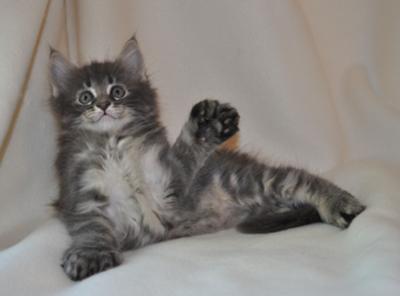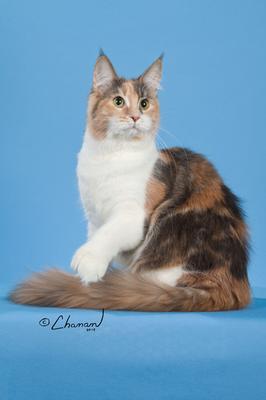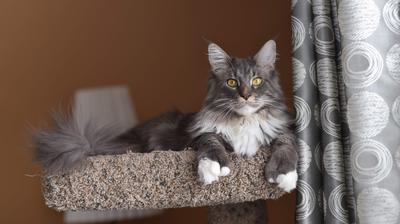- Home
- About Maine Coon Cats
- Maine Coon Polydactyl Cat
The Maine Coon Polydactyl Cat
•
Everyone loves a Maine Coon polydactyl cat! They are so unique and endearing!
Did you know that early in the breed's development, original Maine Coon cats were often polydactyls?
If you like this, you'll love our fun, free Daily Digest!

One of Their Most Endearing Traits!

Because of this, there is a common belief that there is still a connection between the polydactyl gene and this breed.
Let's talk about how rare they are, what their personalities are like, how expensive they are, and more!
These cats are so unique and enchanting!
If you are full of questions about these multi-toed beauties, you are not alone. Most people find them fascinating!
 Buster the Polydactyl Kitten
Buster the Polydactyl KittenMr. Buster is a Blue Classic Tabby Maine Coon polydactyl cat and he is poly on all four feet!
His owner, Linda, shares that he is sweet, laid back, funny and loving.
He loves his big sister Hazel, and loves to go for walks on his harness!
The Maine Coon polydactyl cat personality is friendly, precocious, gregarious, playful and loving.
Just like non-poly Coonies! Having a few extra toes doesn't change their personality, or make them a whole new breed or style of cat with it's one personality traits.
The great news about that is that by going to a reputable breeder, you know exactly what kind of personality your kitten will have.
You can use this same train of thought to answer a lot of questions you may have about these endearing kitties:
"Are polydactyl cats more affectionate?"
Their owners may think so, and it may even seem so! But that is purely anecdotal evidence. All Coonies can be expected to be affectionate. It's how they're bred!
"How big does a polydactyl Maine Coon get?"
Males may be 13-18 pounds, and females range around 8-12 pounds. Some can be much more, and on average that is substantially more than your typical house cat.
Again, this is the same answer as for all Coonies! Visit our page on Big Maine Coon Cats for more.
What Is A Maine Coon Polydactyl Cat?
Breaking down the word polydactyl, poly means "many" and the "dactyl" part refers to the toes.
So, they are "many-toed" cats - cats with more than the usual number of toes! It is a genetically inherited condition.
You may hear this congenital physical anomaly called a gene mutation or physical anomaly, but that doesn't sound very attractive!
How is it Inherited?
 Gorgeous Neo in his post-op shirt
Gorgeous Neo in his post-op shirtPolydactylism is an inherited trait caused by a dominant gene.
This means that if one parent carries the gene, there is a good chance it will be passed to their kittens.
In fact, only one copy of the polydactyl gene is needed for a kitten to be born with extra toes.
It doesn't skip generations but can vary in how many toes appear or where they show up - on the front paws, back paws, or both.
The dominant gene is what makes polydactyl cats more common in some populations.
For example, on the East Coast of the U.S., especially New England, this trait is more frequently seen.
It's thought that sailors favored these cats for their extra toes, believing they had better balance and hunting skills. Over time, many of them were bred, resulting in the spread of the trait.
Because it's dominant, polydactylism can show up in any breed, but it's not exclusive to Maine Coons.
The trait doesn't affect the cat's health or behavior, and a poly kitten will grow up to be just as healthy and active as a non-polydactyl sibling.
Extra toes don't mean any extra care either, aside from trimming more claws during grooming. Breeding polydactyl kittens is relatively simple, and some breeders even specialize in it.
A poly parent is likely to pass on the trait, but there's no guarantee how many kittens will inherit it.
This can result in a mix of both poly and non-polydactyl kittens in a single litter.
"What is the normal number of toes?"
Usually, a cat has eighteen toes. Five on each front foot and four on each rear one. A cat with the polydactyl trait can have up to seven toes per foot.
A cat or kitten can be poly on one, two, three, or four feet. The number of extra toes can vary.
They can have one or more extra toe on a foot, in various combinations. Although usually both front paws match in number, as would both hind paws.
 Tigger is a Handsome Poly Boy
Tigger is a Handsome Poly BoyMost often, it is seen on just the front feet. It's considered very uncommon to see a cat with just the back paws affected, or all four feet.
A cat named Tiger from Canada holds the Guinness World Record for the most toes - twenty-seven!
Polydactyly, or the condition of being polydactyl, is found more often on the East Coast of the United States and Canada, including here in New England, as well as South West England and Wales.
Of course, they can be found in many other parts of the world, as well!
Double-Pawed Cat?
When I was a teenager I met my future husband, and his family had a beloved cat named Alex.
Alex, a domestic short hair, had extra toes on his front feet - they were huge!
The family told me he was double-pawed, and this was the only term I knew for a while. Well, he didn't actually have double paws or double the number of toes. I think he had two extra toes on each front foot.
It's a common and endearing term, but an incorrect one, because there actually is a condition called feline radial hypoplasia.
This condition creates overly large feet that look more like a patty because the toes are not separated as usual.
These cats should not be bred together, because the genetic mutation can become more severe and debilitating in future generations.
Other common terms include snowshoe cat, conch cats, thumb cats, mitten cats, snowshoe cats, and Hemingway cats.
The Ernest Hemingway Home:
The famous American writer Ernest Hemingway was given a white polydactyl cat by a ship captain, and her name was Snow White.
He is well-known for his affinity for these endearing animals, and when he died his house became a home for his cats.
It is said that about sixty cats, some being descendants of Snow White, still reside at his former home in Key West (well cared-for, of course) and many of these have the familiar extra toes.
Is Polydactylism A Sign Of Being A Maine Coon?
 Freebie is a gorgeous calico polydactyl cat
Freebie is a gorgeous calico polydactyl catNo, the only way for a cat to surely be a Maine Coon is for it to have been born to two pedigreed Maine Coon parents in the care of a breeder.
Polydactyl kittens can be found in any and all cat breeds. There are many Domestic Short Haired cats (and this is a style, not a breed) who have additional toes.
However, there is a separate breed called the American Polydactyl.
It is bred as a specific breed, with it's own breed traits and characteristics – including extra toes.
So, what is the connection between the Maine Coon breed and polydactylism?
Well, early on in the discovery, development, and recognition of this breed, many of these cats were many-toed. Why?
One favorite theory is that they were the descendants of long-haired cats brought over from Europe on sailing vessels.
New England Poly History
Did you know polydactyl cats have a long history as shipmates? Sailors once believed these extra-toed cats brought good luck at sea!
Plus, these cats were expert mousers - making them even more valuable on long voyages. Some sailors even considered them lucky mascots!
Their wide paws helped them stay steady on swaying decks, making them excellent mousers even in rough waters.
But their reputation went beyond just balance. Many sailors thought these special cats could predict the weather.
If a ship cat acted restless or hid below deck, it was seen as a sign that a storm was coming. Some even believed polydactyls had a mystical ability to protect ships from rough seas and bad luck.
Over time, these well-traveled felines made their way to ports across the world. Many believe they played a role in the development of the Maine Coon breed, which explains why polydactylism is still common in Maine Coons today!
Early Maine Coons often had extra toes. Many still do today. This trait is part of their history and connection to the sailors of the past.
Those big paws made them excellent mousers and hunters on the high seas, and may have helped them hunt and survive once they disembarked from their long journeys and settled in the Northeast.
 Oliver is a Handsome Poly Maine Coon
Oliver is a Handsome Poly Maine CoonLynn in Michigan shares her beautiful boy, Oliver St. James. She says he is an "energetic red/white 9 month old poly male.
He loves to play and trill at the same time.
He loves to play with his older brothers and sister but they don't seem to understand how he can pick up toys using his thumbs and they can't?"
So to answer the question "what is the difference between a Maine Coon and a Maine Coon polydactyl cat?" - the difference is just some extra toes!
Are Most Maine Coons Polydactyl?
Good question! This trait is not allowed in "show cats" so it is not common to see nowadays. Many breeders participate in showing their cats.
That's a big part of what the passion for cat breeding is all about!
It is unfortunate that a magnificent feline would be denied the chance to become a champion just because this trait is deemed a "fault."
So breeders used selective breeding to effectively breed fewer polys, in order to produce show cats.
Because of this, there are groups and organizations with an eye to bringing polydactyl cats back into the show ring.
But if you love polydactyl Maine Coons, take heart!
There are breeders who specialize in breeding polydactyl Maine Coon cats and kittens. These are fully registered, pedigreed, purebred cats. Every bit a Maine Coon – plus some extra (toes, that is)!
It's important to note that all purebred polydactyl Maine Coon Cats are full Maine Coons in every way, including pedigree.
 Harley, a Classic Brown Tabby Poly
Harley, a Classic Brown Tabby PolyMeet Harley, a Classic Brown Tabby from Barncat Maine Coons in Massachusetts.
He has six toes, a wonderful personality, and really likes to make use of his thumb!
Frequently Asked Questions (FAQ's):
"How rare is it for a Maine Coon to be a polydactyl?"
It's relatively uncommon at this point, due to it having been bred out. And finding a poly on all four feet is a special find indeed!
 Lucy
LucyBut they are not that rare. In fact, our community has so many unique polydactyls - like Lucy, who proudly sports extra toes.
With a little searching, one can easily find a breeder that may have upcoming or planned litters of possible polys. The hard part will be the waiting!
"How much is a polydactyl Maine Coon?"
The cost of any Maine Coon will depend on a few factors, such as pedigree, location, unusual features or coloring, and more.
Since polys are harder to come by, expect them to cost more than their non-poly counterparts! Costs can be very variable, so it's best to ask the breeder directly.
You can visit our page on the cost of Maine Coons for more info on the topic.
Extra-Toed Cats and Their Grooming Quirks
 Toe-Bee's Toes!
Toe-Bee's Toes!Those big, mitten-like paws aren't just cute - they make a real difference in how these cats move, groom, and play.
Depending on how their toes are arranged, some have just a thumb-like digit, while others have full extra toes that spread their paw like a snowshoe.
No one shows it off better than Toe-Bee, whose photo from Amy captures those extra beans in all their glory.
Because of this, nail care can take a little extra attention. The inner claws, especially the "bonus" ones, often grow at sharper angles and can hide behind fur or pads.
Keeping an eye out during regular grooming helps prevent overgrowth or irritation.
Cats with wider paws also interact with their world differently. They dig into scratching posts with more surface pressure and sometimes prefer flatter scratchers or heavy posts that don't tip.
A few even grip toys or furniture edges in surprisingly human-like ways.
Playtime shows off their dexterity most! They grab, scoop, and sometimes even "hold" toys as if they had thumbs.
It's all part of what makes these cats so fun to live with: a mix of quirk, intelligence, and coordination packed into those extra toes.
"Are there any health issues Maine Coon polydactyl cat owners should know about?"
None! They are wonderful, healthy cats with extra digits. If you clip your cat's claws (or have them clipped), just plan on clipping some extra claws. That should be the only special care they need!
Louise in Canada has a beautiful Blue poly boy named Mobi, and tell us: "He has two extra digits on each paw which is a challenge as he does not like his claws to be trimmed."
 Mobi with his poly paws hanging out
Mobi with his poly paws hanging outBig Paws, Big Myths!
Are they all better mousers? Not necessarily! Cats will be cats, and they each have their own distinct personality. Although most cats love to chase mice, there are those that don't.
They might be excellent mouse hunters and may even have better balance than other domestic cats.
My Leo could catch a mouse, but he'd always set it back down and it would run off.
Once, he set it down in his food dish, to save it for later, as he did with his toys! The mouse was very grateful, and we found it hilarious!
 Hunter showing off his polydactyl foot!
Hunter showing off his polydactyl foot!With that said, owners of polydactyl cats will notice that the extra size on those paws is an advantage for mousing, and for balance as well.
I have heard some say that it also helps them walk on snow better than their non poly counterparts, as in the ability to walk across it without falling through - like when wearing snow shoes.
As a native Mainer very familiar with snow, I think I'd need to see this to believe it!
So there you have it, the Maine Coon polydactyl cat is a healthy, hearty, and endearing cat! You want one, now, right?
« Head back to our Maine Coon Cats Exposed hub to explore more fascinating features - from quirky habits to rare coat types.
References:
Leeson, J. (2024, August 22). Polydactyl cats: What to know about cats with 'Thumbs' https://www.petmd.com/cat/general-health/polydactyl-cats

